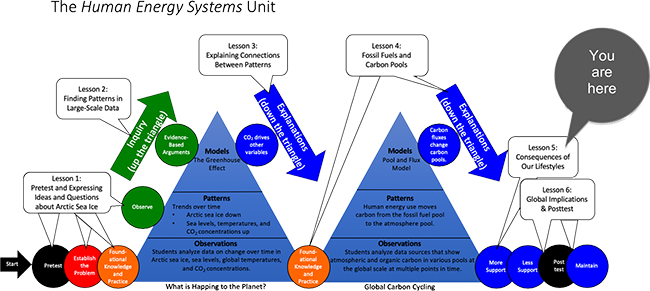Transformations in Matter and Energy Carbon TIME is an NSF-funded partnership led by Michigan State University
Human Energy Systems | Lesson 5 - Consequences of our Lifestyles
Overview
Students examine ways humans use carbon as individuals and compare how people around the globe use carbon for transportation, food, housing, and electricity.
Guiding Question
How do we use organic carbon and emit CO2 in our lives?
Activities in this Lesson
- Activity 5.1: Extreme Makeover: Lifestyle Edition (45 min)
- Activity 5.2: Carbon Emissions Jigsaw (60 min)
- Activity 5.3: Energy Scenarios (30 min)
- Activity 5.4: Strategies for Lowering Carbon Emissions (45 min)
Unit Map

Target Student Performance
|
Lesson 5 – Consequences of Our Lifestyles (students as explainers) |
|
|---|---|
|
Activity |
Target Performance |
|
Activity 5.1 Extreme Makeover: Lifestyle Edition (45 min) |
Students choose preferred lifestyles based on data about four countries (United States, France, China, Ethiopia) and compare CO2 emissions based on those lifestyles. |
|
Activity 5.2 Carbon Emissions Jigsaw (60 min) |
Students explain the mechanisms through which human activities and technologies in four different areas (electricity, transportation, buildings, food) lead to CO2 emissions. |
|
Activity 5.3 Energy Scenarios (30 min) |
Students explain how different personal activities (energy scenarios) lead to CO2 emissions. |
|
Activity 5.4 Strategies for Lowering Carbon Emissions (45 min) |
Students create and share posters explaining strategies for reducing CO2 emissions. |
NGSS Performance Expectations
High School
- Ecosystems: Interactions, Energy, and Dynamics. HS-LS2-5. Develop a model to illustrate the role of photosynthesis and cellular respiration in the cycling of carbon among the biosphere, atmosphere, hydrosphere, and geosphere.
- Earth and Human Activity. HS-ESS3-6. Use a computational representation to illustrate the relationships among Earth systems and how those relationships are being modified due to human activity.
Middle School
- Human Impacts. MS-ESS3-4. Construct an argument supported by evidence for how increases in human population and per-capital consumption of natural resources impact Earth's systems.
- Earth and Human Activity. MS-ESS3-5. Ask questions to clarify evidence of the factors that have caused the rise in global temperatures over the past century.

 Download PDF of Lesson 5 Teacher's Guide
Download PDF of Lesson 5 Teacher's Guide